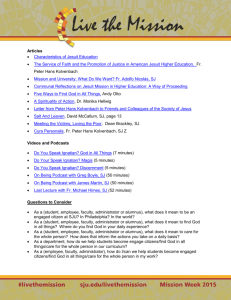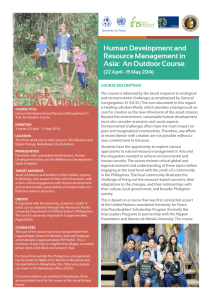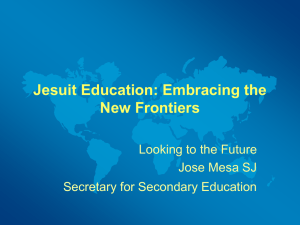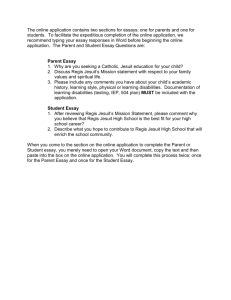Where in the World is St - Colleagues in Jesuit Business Education
advertisement
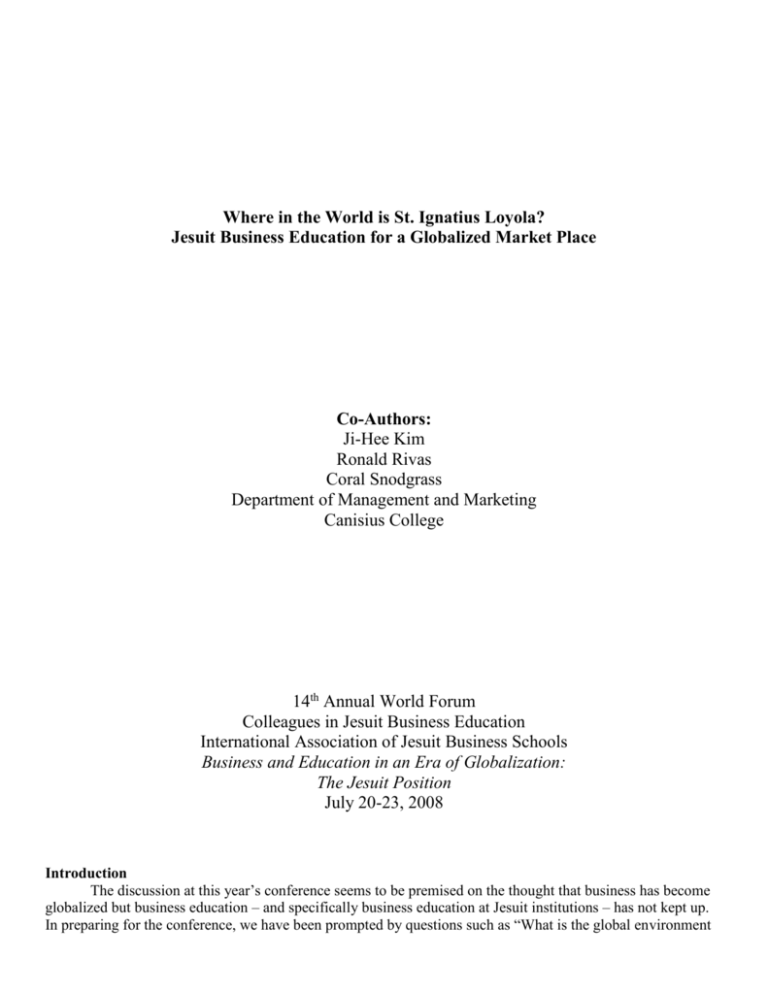
Where in the World is St. Ignatius Loyola? Jesuit Business Education for a Globalized Market Place Co-Authors: Ji-Hee Kim Ronald Rivas Coral Snodgrass Department of Management and Marketing Canisius College 14th Annual World Forum Colleagues in Jesuit Business Education International Association of Jesuit Business Schools Business and Education in an Era of Globalization: The Jesuit Position July 20-23, 2008 Introduction The discussion at this year’s conference seems to be premised on the thought that business has become globalized but business education – and specifically business education at Jesuit institutions – has not kept up. In preparing for the conference, we have been prompted by questions such as “What is the global environment for business education?” and “Are business schools truly global?” An implied notion is that once “global” is introduced into the discussion, dimensions of complexity, uncertainty, dynamism and change that haven’t been explicitly incorporated into our educational models must now be addressed. The problem, of course, is that complexity, uncertainty, dynamism and change generally don’t easily submit to static modeling. So, in our paper we have decided not to try to actually answer a question but rather to discuss some interesting questions that we think should be asked. We start with one basic question: “What will a business student who has been educated in the Jesuit tradition do to enact that tradition in the global market place?” This question leads us to the first question we need to try to answer. What is the Jesuit tradition? Actually, the real question we need to ask is: “What is the Jesuit Tradition as it pertains to business education?” But we need to start somewhere. One way to start to try to answer the question is to go to the websites of the Jesuit Colleges and Universities to see what they say the “Jesuit Tradition” is. When one does that, one finds discussions of “educating the whole person”, “promoting Catholic intellectual life”, “working for a more just and peaceful world”. Unfortunately, the Jesuit Tradition seems a little short on implementation guidelines. Guidance on implementation can be found in the Mission Statements of these schools. Thus a curriculum should “prepare students to assume positions of leadership” and “foster an atmosphere of understanding and respect”. These are still a little short on specific guidelines for specific majors such as Accounting and Management Information Systems. One theme that permeates the mission statements of Jesuit institutions and that does provide some direction for action is the need to “use one’s gifts for the service of others and the benefit of society”. So, the first conclusion we can make about curriculum design is that it should prepare students to recognize the “Other” and to find ways to “serve”. This leads to the next question: Who is the “Other”? It is all very well and good to tell students to use their gifts in the service of the “Other”. But it is not clear who this is. In his discussion of the Jesuit Core Curriculum, Fr. Stephen Privett (2003) is quite clear on who he thinks the “Other” is. For him, the “Other” includes: The 75% of the world that does not keep its food in a fridge, its clothes in a closet, have a roof over its head or a bed to sleep in The 35,000 children who die everyday from hunger and hunger related causes The 3 billion people who live on less than $2.00 a day The 99 people out of 100 who do not have a university education He further states that, “…it would be difficult for me to accept a core set of learning experiences at a Jesuit university that do not provide opportunities for personal involvement with the innocent suffering of the poor and the marginalized among us…. One responsibility of the core at a Jesuit university, given the overarching purpose of education and the state of our world, is to plant students’ feet in the lives of the poor and the vulnerable, if only metaphorically.” He concludes with, “The challenge of Jesuit education is to nurture that sense of obligation which calls us to a humane way of being in the world as it is, while also offering the knowledge, wisdom and judgment that enable us to meet our obligation to do what we can, even when there is not much that we can do.” Of course, Fr. Privett was talking about the design of a Jesuit Core Curriculum. It isn’t clear how that translates to a Jesuit Business Curriculum. Who are the “Others” that business majors will be serving when they graduate? If we assume that our students will be working in corporations, they will be serving the company’s stakeholders. That would include shareholders – some of whom are certainly not from the group described above – workers, customers, suppliers, subcontractors, regulators, competitors, and any one else with some legitimate stake in the firm all over the world. How can their needs be identified and served? And how can conflicting needs be served? What happens when we expand this to the global market place? To begin to figure that out, we ask a series of questions. How will business students participate in the global marketplace? It seems reasonable to start our consideration of the design of a curriculum that will prepare our business students to participate in the global marketplace by considering exactly what it is that our students will be doing when they enter the global marketplace. First of all, we are concerned about educating business students. So, we are not talking about educating students for missionary work, the government, the law or education. We are talking about preparing students to work in business organizations. What does that mean? In post-agrarian societies, such as the ones our students will be working in, “business organizations” are given the right to provide the goods and services that people want but that they can not or do not want to provide for themselves. Business people take on the task of putting together sufficient resources to provide the goods and services that society wants and society gives them something in return – something that we will call “money.” To reward business persons for taking on the task of providing these goods and services and bearing the risk that they may not have provided the correct goods and services, society allows business people to keep whatever “money” is left over after the costs of goods and services sold have been covered – something that we will call “profit.” In the simplest organizational form, the single business person puts in their own money to provide the goods and services and gets to keep the profit. In the more complex organizational form, an individual (the “manager”) takes money from others (“investors/ owners/ shareholders”), hires some people (“employees”) who help to provide the goods and services, and gives what ever is left over back to the owners (in the form of dividends and/or capital appreciation, in the case of secondary markets). So, how will our students participate and what do we need to teach them? They could be the “simple business person” who discovers yet another good or service that society needs – what we will call the “entrepreneur”. So, we need to design a curriculum that will prepare our students to recognize the needs of “Others” – some of whom may be those “Others” that Fr. Privett identified. But not all of our students will be entrepreneurs. Many of them will enter the global marketplace as one of the persons responsible for doing what it takes to get the goods and services that society wants out there to the marketplace and divvying up the profits – what we call “managers.” So, we also have to address issues of preparing students to be managers who can balance the needs of many “Others” while fulfilling their fiduciary responsibilities to the people who entrusted them with their money. How do we do that? What do we already teach that might be useful? In his discussion of the appropriate preparation for students in Jesuit institutions, Fr. Kolvenbach (2007) states: “Students, in the course, of their formation, must let the gritty reality of the world into their lives, so they can learn to feel it, think about it critically, respond to its suffering and engage it constructively. They should learn to perceive, think, judge, choose and act for the rights of others, especially the disadvantaged and the oppressed.” So, students need to “let the gritty reality of the world in.” That is probably best done through internships, study abroad and service learning. Most of our business schools have those programs. So, we’re okay there. But what about all this “critical thinking” and “acting for the rights of others”? Well, we all have some sort of course dealing with what we can call “Corporate Social Responsibility”. In these courses, we teach students how to identify and balance the conflicting needs of business, government and society. We examine primary reciprocal relationships among the three and the mechanisms for adjudicating their conflicting needs, i.e., the market, the legal system and the political process. We teach students how to recognize the primary, secondary and tertiary impacts of their decisions as managers. We show them how to build decision models that take these impacts into effect and design rules of behavior – “first, do no harm; secondly, if you can help the company and society, everybody wins” (the proverbial “win-win situation”). We exhort them to be creative in their problem solving (e.g., “Assume that you cannot close the plant and move the jobs to Mexico. Then what will you do???”) And there is certainly evidence that managers – even some who have not been educated in Jesuit institutions – have taken the concepts of corporate social responsibility to heart and have tried to enact their values in the globalized marketplace. As an example, in the January 19, 2008 issue of The Economist in a special report on corporate social responsibility, they reported on the work being done at Marks & Spencer (M&S), a British retail outlet. At M&S, they have taken on a 5 year plan that has 100 social outcomes such as: give 15,000 children in Uganda a better education save 55,000 tonnes of CO2 in one year recycle 48 million clothes hangers triple sales of organic food convert over 20 million garments to Fairtrade cotton It certainly sounds like they are trying to serve the needs of “Others”, especially Ugandan school children and cotton farmers all over the world. Of course, this does beggar the question of whether or not we have identified the “correct Others”? Are Ugandan school children inherently more worthy of a manager’s time and efforts than are Nigerian school children? Pakistani school children? Students at Grover Cleveland High School in Buffalo, NY? Ecuadoran senior citizens? Clearly, even for companies that want to do good – and The Economist article indicates that there is no shortage of them that do – there is no clear idea of what exactly they should be doing. In the article, they report on a survey of the issues that will “matter the most in the next 5 years”. In Britain and Brazil, saving the environment is the most important issue. In the United States and China, the issue seems to be health care. Other research indicates that companies should concentrate on those matters they can control and where they can really make a difference – e.g., minimizing their carbon footprint, controlling human rights across their global supply chains, addressing issues of sustainability. But whatever it is they are doing, there seem to be plenty of firms out there that have embraced the concepts of corporate social responsibility – concepts that we already teach at our Jesuit Colleges and Universities. These are companies that our students can feel comfortable in joining since it would be there that our students could enact the Jesuit traditions in the global marketplace. Or can they? There is always the point that we have to come back to when we teach “Corporate Social Responsibility”. If managers choose to use corporate resources to do anything other than “maximize shareholder wealth”, they are playing with other people’s money. If managers divert resources away from maximizing the return to the stockholders without their knowledge and permission, isn’t that stealing? We can’t be saying that we want to build a curriculum that teaches out students to steal. And how far away from the company’s core business can a manager afford to divert resources, even with the stockholders’ knowledge and permission? If the company goes out of business, is that “good”? And doesn’t a company do good just by doing what it does? As an example, Oxfam conducted a study of Unilever in Indonesia in 2004. The study, reported in The Economist, showed that Unilever “supported the equivalent of 300,000 fulltime jobs across its entire business, created a total value of at least $630m and contributed $139m a year in taxes to the Indonesian government.” Would it be better if did something else? This also introduces the problem of trying to measure non-financial outcomes. While there have been attempts to measure these social benefits – e.g., performing social audits – the results don’t seem to have easily digestible information for decision makers. And it is difficult to determine whether or not doing good is good for the company. Years of research have indicated that being a “good corporate citizen” does not pay off in the market place (Vogel, 2005). At best, it doesn’t seem to hurt a company’s long term viability. However, this means that a corporation that chooses to divert some of its resources to social goals can still compete successfully against some firms that are not diverting their resources. So, making our students go through the cases, problem solving and decision modeling that we already do in our “Corporate Social Responsibility” courses can at least give them good practice in recognizing the conflicting needs of all “the Others” they will serve when they are managers. But we still haven’t answered questions of trying to determine the correct “Others” to finally choose to serve. What we rarely teach that might be useful In the January 24, 2008 edition of The Wall Street Journal, Bill Gates called for a “kinder capitalism” or, in his words, “creative capitalism that uses market forces to address poor-country needs….” Mind you, this is the same Bill Gates who brought you Vista. But putting that aside for the moment, it is fair to say that Gates believes that companies can fulfill their goal of making profits while still helping others. In this new world of concerned capitalists, instead of having to work only for non-profit organizations (such as the Bill and Melinda Gates Foundation), our students could work for for-profit companies and still fulfill their needs to help “Others”. And as long as companies make these goals explicit in their mission statements, potential investors and potential employees will know that the company’s managers will be diverting funds – think Google or Ben & Jerry’s. The question still remains about how to decide who the appropriate “Others“ are – Ugandan school children, Egyptian cotton farmers, widowed bondholders in Iowa? In the context of the founder of the firm, the answer is somewhat simple – the “Entrepreneur” gets to decide. In the context of the corporation, the answer is a bit more complex, but it is clear that the direction has to come from the top – from the “Leader”. So, there are two themes that we need to address in our curriculum design – Social Entrepreneurship and Leadership – if we are to prepare our students to be able to enact the values we have taught them when they enter the global marketplace. Is Social Entrepreneurship the Answer? Social Entrepreneurship is about using entrepreneurial skills to craft innovative responses to social problems. It aims at social impact but does not exclude economic wealth creation. Thus it is not limited to the non-profit sector. Social Entrepreneurship involves recognizing opportunities, combining and mobilizing resources, triggering positive change in various domains, and building sustainability. Social entrepreneurship can include social purpose business ventures and for-profit elements. Any definition of social entrepreneurship should reflect the need for a substitute for the market discipline that works for business entrepreneurs. Social entrepreneurs look for the most effective methods of serving their social missions, business owners and leaders integrate social responsibility into their operations. Social entrepreneurs play the role of change agents in the social sector, by: Adopting a mission to create and sustain social value (not just private value) Recognizing and relentlessly pursuing new opportunities to serve that mission Engaging in a process of continuous innovation, adaptation, and learning, Exhibiting heightened accountability to the constituencies served and for the outcomes created (J. Gregory Dees, 2001, “the Meaning of Social Entrepreneurship) If we are going to teach our students how to become “Social Entrepreneurs” who can choose to use their gifts in the service of others, possible course topics would include: An Introduction to Social Entrepreneurship concept, practices, opportunities, and challenges The Creative Process of Social Entrepreneurship Developing the Social Enterprise Concept Social Enterprise Business Plan Measuring Social Value Effective Leadership of Social Enterprise The Course Objective would be to focus on how to bring and adapt business skills to the social sector. The course would provide a conceptual framework for thinking strategically about innovation in the social sector. Specifically, the activities would include: To review Social Entrepreneurship as an alternative paradigm to combine social and economic value creation. To examine the challenges and rewards of entrepreneurship, intrapreneurship, and management in creating and developing social purpose organizations To build the knowledge, skills, and attitudes necessary for responding successfully to the challenges To provide an appreciation of the relative strengths and weaknesses of different organizational forms, not-for- profit and for-profit, in providing social goods and services To provide students with an understanding of the complex dynamics underlying Social Entrepreneurship as a global phenomenon. To invite students to look beyond traditional boundaries and critically assess alternative ways of doing business and creating social value. To define new possible roles and strategies for entrepreneurs, leaders and established companies to address social needs and contribute to sustainable To examine the changing circumstances in a globalizing world and the conditions to set up a social enterprise To understand and analyze strategic challenges social entrepreneurs face at different stage of the initiative, such as e.g., how to get started, how to reach the right scale, how to build up effective networks, and how to replicate the idea internally, the role social entrepreneurship plays in the context of sustainable development. Who would benefit from the course? All students who want to understand and analyze strategic challenges social entrepreneurs face at different stages of the initiative, such as how to get started, how to reach the right scale, how to build up effective networks, and how to replicate the idea internally, the role social entrepreneurship plays in the context of sustainable development. All students interested in creating both social and economic value Students who aim at making a difference in their environment and aspire to engage in a socioentrepreneurial initiative in the context of a newly created enterprise, or established for-profit, and nonprofit organizations Students who plan to work in or as a consultant for the social sector or for non-profit organization and want to improve their understanding of the functioning of social entrepreneurial initiatives Teaching Social Entrepreneurship will provide our students with the skills necessary to be able to build a successful organization that addresses both economic and social goals. In addition, students who plan to work in or as a consultant for the social sector or for non-profit organizations will improve their understanding of the functioning of social entrepreneurial initiatives. Students will be exposed not only to the concept of Social Entrepreneurship and its various applications across sectors, organizational forms, and geographical locations but also to “Social Intrapreneurship”, i.e. innovative social initiatives within established firms. But for that, they need some form of “Leadership”. Is Global Ignatian Leadership the Answer? What type of leadership do leaders of business organizations that want to serve “Others” by following the Jesuit tradition need to practice in a globalized world? Globalization is a multidimensional process of incomplete and differential cross-country integration at a worldwide scope. Anthropologists emphasize the cultural implications of global integration. Economists focus on integration of financial markets, transnational capital flows, and the post-national production and distribution of goods and services. Political scientists associate globalization with human and civil rights across borders. A broader definition of globalization would include the integration of countries along Political, Economic, Technological, Socio-cultural, Ecological lines, among other aspects of human activity. Global integration creates business challenges from these diverse aspects of the environment. In such a diverse context, globally responsible leaders at all organizational levels face four key challenges. First, they act in a global context. Second, they ultimately affect society around the globe. Third, they are bound to face conflicting ethical challenges from their multi-country activities. Fourth, and perhaps the most relevant to higher business schools, they eventually set precedent through their actions of what business schools will eventually regard as “good” (or bad) business practices. Given such critical challenges in an increasingly globalized world, there is a crucial need to understand what constitutes globally responsible leadership. The European Foundation for Management Development (EFMD) launched in 2002 the Globally Responsible Leadership initiative (GRL), which has become an ever growing group of learning institutions, non-governmental institutions, and multinational corporations from around the world. In their 2006 report “A call for engagement” the EFMD GRL initiative stated: The purpose of the globally responsible business is to create economic and societal progress in a globally responsible and sustainable way. The leadership required now and in the future can be described as globally responsible leadership. This is the global exercise of ethical, values-based leadership in the pursuit of economic and societal progress and sustainable development. It is based on a fundamental understanding of the interconnectedness of the world and recognition of the need for economic and societal and environmental advancement. It also requires the vision and courage to place decision making and management practice in a global context. According to the EFMD, Globally Responsible Leadership is: 1) Global (it has worldwide impact). 2) It exercises ethical, values-based leadership. 3) It pursues economic and societal progress. 4) It seeks sustainable development. 5) It is based on a fundamental recognition of the interconnectedness of the world. Although this type of leadership resonates with the Ignatian tradition of social justice, there are significant elements that need to be clarified if one would apply it to a Jesuit Business School. A closer look to a typical mission statement of a Business School of an American Jesuit College would help to identify similarities and differences between GRL and a Jesuit based business leadership. As an example, the Canisius College mission statement posted on the College website states: Canisius espouses the ideal of academic excellence along with a sense of responsibility to use one's gifts for the service of others and the benefit of society. It seeks to promote the intellectual and ethical life of its students, helping to prepare them for productive careers as well as for meaningful personal lives and positive contributions to human progress. Its curricular and co-curricular programs are designed to educate the whole person through development of intellectual, moral, spiritual, and social qualities. It aims to promote the contemporary Jesuit mission of the service of faith and the promotion of justice.(Emphasis added.) Hence, Globally Responsible Business Leadership in the Jesuit tradition is: 1) Global (it has a worldwide impact on society) 2) It exercises the ethical directive of “Service of others and the benefit of society.” 3) It pursues economic and societal progress that fosters human dignity (human progress). 4) It seeks sustainable development. 5) It is based on a fundamental recognition of the interconnectedness of the world. 6) It practices sound management practices. Business leadership based on the Jesuit tradition highlights the dichotomy between the ethical, inspirational, type of leadership versus the managerial, shrewd business professional type of leadership. Thirty years ago, Burns (1978) published his seminal work introducing the concepts of transformational and transactional leadership. Whereas transformational leaders uplift the morale, motivation, and morals of their followers, transactional leaders cater to their followers’ immediate self-interests. A transformational leader is charismatic, inspirational, provides intellectual stimulation, and gives individualized consideration. A transactional leader manages by reward or exception, and is task oriented (Burns, 1978; Bass, 1990, 1999). Jesuits Business Schools face the challenge of fostering in students a demanding combination of both transformational and transactional leadership. The type of transformational leadership advocated by the typical Jesuit business school mission statement could be referred to as “Ignatian Transformational leadership.” Figure 1 shows four dimensions of the Ignatian Transformational Leadership (Please, see Figure 1). The main mandate of this type of leadership is the “Service of Others and the Benefit of Society.” A central characteristic of this type of leadership is to exert an idealized influence on society. As Saint Ignatius was moved by his profound faith and by divine inspiration, an Ignatian transformational leader is an ethical charismatic leader inspired by faith. The main inspirational motivation of such leadership is to serve mankind (Men and women for others). Such leadership promotes intellectual stimulation (educates the whole person). Finally, the Ignatian transformational leader cares for the individual (Individualized consideration). Figure 1. Ignatian Transformational Leadership: Four Characteristics. “Idealized Influence” Ethical Charismatic (Inspired by Faith) “Individualized Consideration” Care for the individual Ignatian Transformational Leadership: Service of Others and Benefit of Society “Inspirational Motivation” Men and Women for Others “Intellectual Stimulation” Education of The whole person However, how could we achieve educating our business students in both mandates, i.e., the Ignatian Transformational leadership and the business transactional leadership? Figure 2 shows four generic strategies of curricular development for Jesuit Business schools. The easiest strategy is “Laissez-Faire,” one strategy that no Jesuit Business school must pursue. In this scenario, the curricula does a poor job instilling the values of Ignatian Transformational leadership across courses as well as doing a poor job of teaching sound managerial practices. A perhaps more typical strategy is to pursue “Managerial Leadership.” In this scenario, a Business School would excel in managerial training, though it would do a poor job instilling the Ignatian Transformational leadership values. An extreme strategy is to pursue “Visionary Leadership.” In this setting, much emphasis is placed on instilling the values of Ignatian Transformational leadership to the detriment of training of sound managerial practices. This would be akin to try to forming idealistic missionaries instead of managers. Finally, a challenging strategy is “Global Ignatian Leadership.” Here, business schools would educate a student in both the practice of Ignatian Leadership values and the state of the art in managerial practices. Figure 2. Four Generic Strategies for Jesuit Business Schools’ curricular development Service of Others and Benefit of Society “Ignatian Transformational Leadership” LOW HIGH Visionary Leadership Laissez-Faire HIGH Globally Ignatian Leadership Managerial Leadership LOW Transactional Leadership Global Ignatian Leadership is challenging because it is counter-cultural, in so much as it is set against the prevailing profit-seeking business culture. It demands personal sacrifices due to the personal costs of making decisions counter to self-interest. Furthermore, it demands sacrifices of business organizations due to the cost incurred in diverting resources previously devoted to share-holders-self-interest and allocating such resources to satisfy other society’s interests. Therefore, Global Ignatian Leadership will not happen spontaneously. It would require a substantial multidimensional and shared investment by students, faculty, university administrators, corporations, engaged share-holders, and supporting institutions at large. However, the payoff of implementing a “Global Ignatian Leadership” strategy for business schools is to have a legitimate “distinctive competence” in the marketplace. For the rest of us, in the long run the payoff is a world with leaders engaged in building a sustainable and more socially just type of globalization. To implement the Global Ignatian Leadership strategy, issues pertaining to this approach should be integrated across the business school curriculum, not just in stand-alone courses. Curricula for both degree and executive programs need to be enriched by topics such as: Analysis of globalization trends. Analysis of existing ethical codes and study of successful implementation of organizational Ignatian ethical codes and principles. The development of global Ignatian leader-linked attributes and behaviors. Cross cultural understanding and language skills. Social and environmental accounting and reporting. Sustainable business practices. A range of innovative approaches to pedagogy and learning needs to be tested and utilized which engage more of the whole person and service to Others and Benefit of Society in the learning experience. Integration of Business schools and other divisions on Campus seeking support and synergies on crosscurricular development. Conclusion Those of us who teach business at Jesuit institutions need to find ways to help our students use their gifts in the service of others. They need to be able to do this in all contexts – including the corporate one. Is it enough to tell them that they have to be entrepreneurs in order to enact the values we presumably have taught them? This does seem to be ducking the issue. So, the question still remains: What will a business student who has been educated in the Jesuit tradition do to enact that tradition in the global market place? The answer does not seem to be an easy one. But we need to come up with something soon. As The Economist special report indicated, firms are embracing the concepts of corporate responsibility. An article in the May, 2008 edition of Continental Magazine reports that business students want to work for firms that are good citizens and they want to go to schools that teach them how to behave as socially responsible managers. In their ranking of business schools that offer “alternative” business curricula, the Aspen Institute listed as the top ten: 1. Stanford University 2. University of Michigan 3. York University (Canada) 4. University of California – Berkley 5. University of Notre Dame 6. Columbia University 7. Cornell University 8. Duquesne University 9. Yale University 10. Instituo de Empresa (Spain) One cannot help but notice that there are no Jesuit Colleges or Universities on the list. Clearly, this conference did not come a moment too soon!! References Bass, B. (1990) “From Transactional to Transformational Leadership. Learning to Share the Vision,” Organizational Dynamics, Winter90, Vol. 18 Issue 3, p19-31, 13p Bass, B. (1999) “Two Decades of Research and Development in Transformational Leadership,” European Journal of Work & Organizational Psychology, Mar1999, Vol. 8 Issue 1, p9-32, 24p Brooks, Arthur C. (2008), Social Entrepreneurship: A Modern Approach to Social Value Creation, Prentice Hall, New Jersey. Burns, J.M. (1978). Leadership. New York, NY: Harper & Row Canisius College Mission Statement. http://www.canisius.edu/about/mission_statement.asp Dees, Gregory (2001), "The Meaning of "Social Entrepreneurship", Retrieved from "http://www.usasbe.org/knowledge/socialentres/" The Economist (2008), Special Report on Corporate Social Responsibility. January 19,-25. European Foundation for Management Development (EFMD) 2006. "Globally Responsible Leadership: A Call for Engagement," http://www.globallyresponsibleleaders.net/content/view/58/136/ Guth, Robert A. (2008). “Bill Gates Issues Call for a Kinder Capitalism”. Wall Street Journal. January 24, 2008. Kolvenbach, Rev. Peter-Hans (2007). Education for a Globalized World. AJCU Publication. Mair, Johanna & Ignasi Marti(2006), "Social Entrepreneurship research: A source of explanation, prediction, and delight", Journal of World Business 41 (2006), 36-44 & also available online at www.sciencedirect.com Privett, Rev. Stephen (2003). Keynote Address. Third Jesuit Core Curriculum Conference. Xavier University, Cincinnati, Ohio. Vogel, David (2005). “Is there a market for virtue?” California Management Review. 47(4) pp. 19-45. Warren, Chris (2008). “Good Business”. Continental Magazine. May.

